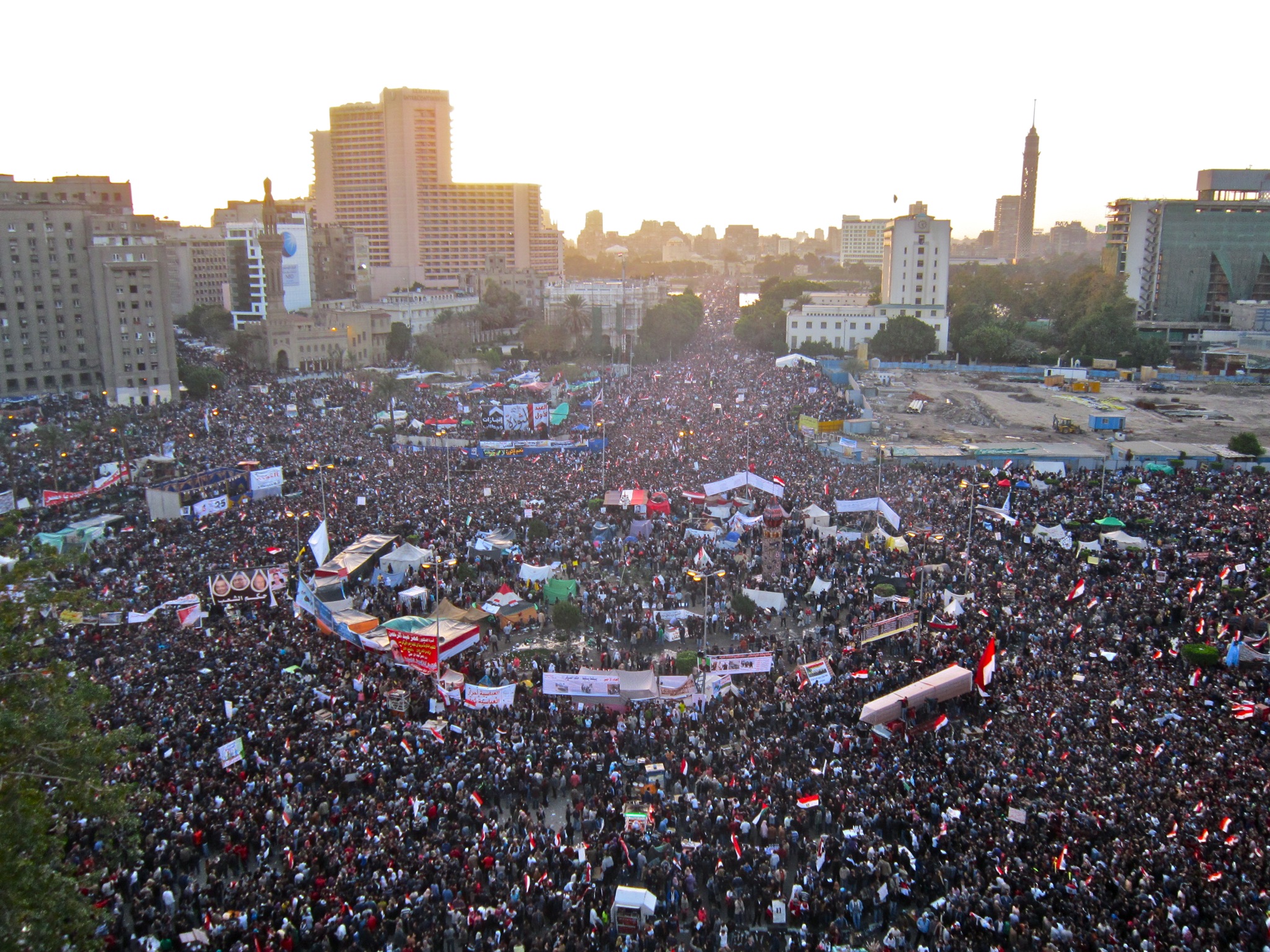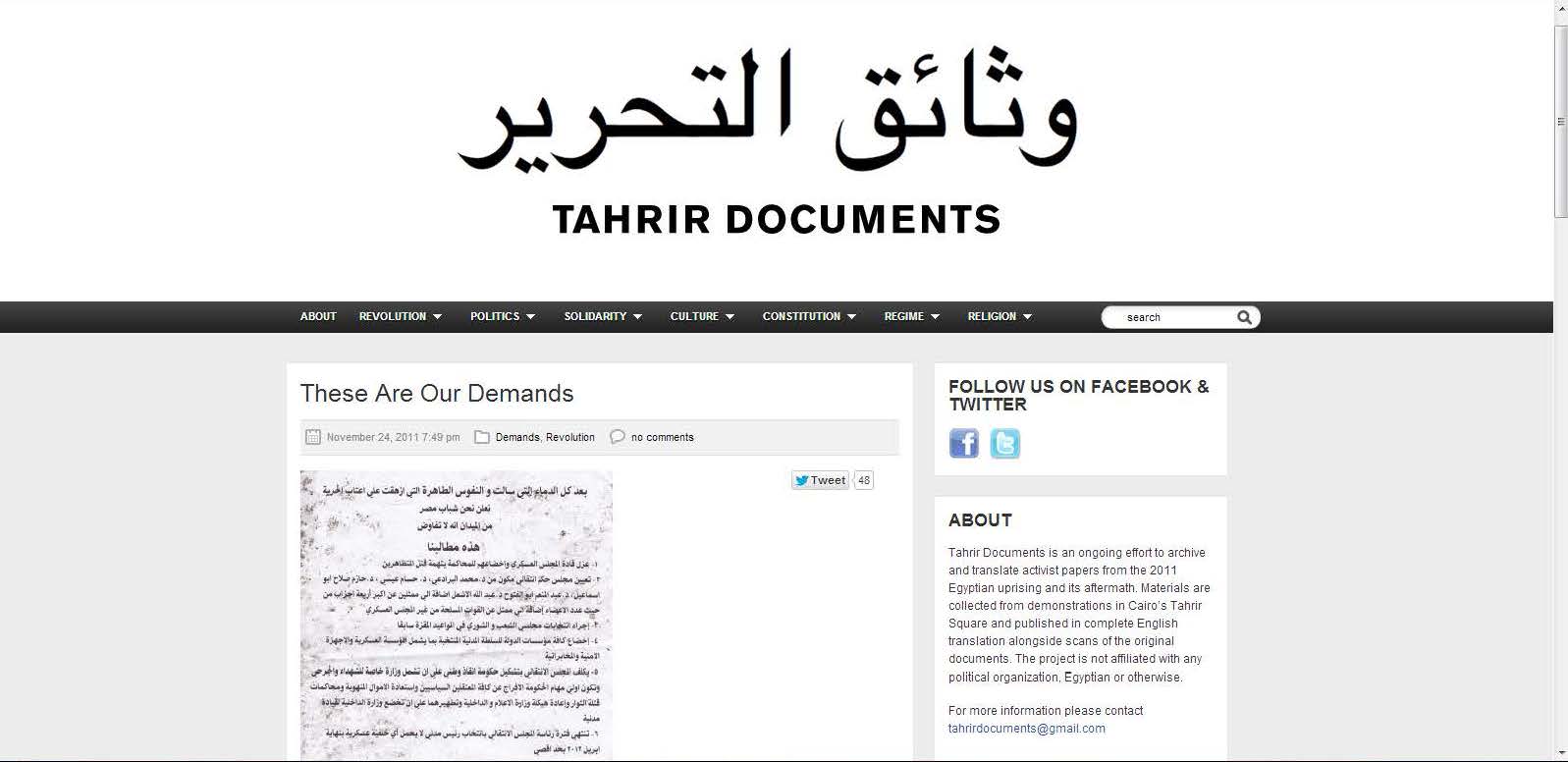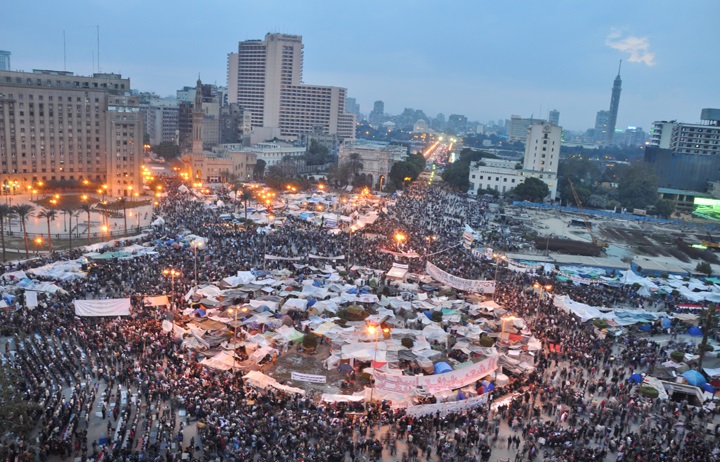Tahrir Documents is a collection of pamphlets, newsletters, signs, poems, and other texts gathered in and around Tahrir Square in Cairo, Egypt, between March 2011 and May 2012. The physical documents are housed at the University of California, Los Angeles (UCLA) in the Department of Special Collections at the Charles E. Young Research Library. However, all documents are available online at www.TahrirDocuments.org as scanned PDF files with accompanying English translations. The archive seeks to create a record of the print culture of the Egyptian uprising against Hosni Mubarak and its aftermath.

History
Tahrir Documents was founded in 2011 through the efforts of a group of American graduate students in Cairo and explicitly states its lack of affiliation “with any political organization, Egyptian or otherwise.” Generally speaking, documents were gathered once a week on Fridays, when they were distributed to crowds in Tahrir Square. They were then scanned and translated by volunteers, primarily Egyptians and Americans, a number of whom were students of the Center for Arabic Study Abroad (CASA). The founders of Tahrir Documents intended the archive to illustrate the richness and diversity of print culture in Tahrir Square at a time when media discourse on the “Egyptian Revolution” gave primacy to the impact of online social media such as Facebook and Twitter. Further, translating these documents into English represented an attempt to give the diverse and polyvalent texts available in Tahrir Square a wider English-speaking readership. Efforts to collect and translate documents continued through May 2012, at which point no further documents were added to the collection.
Collection
The collection includes a wide range of documents collected in and around Tahrir Square from spring 2011 to spring 2012, including newsletters and broadsheets, pamphlets, announcements, advertisements, and poetry. The archive also includes a small number of largely text-based signs held by protestors at Tahrir Square. Though most of the documents are stand-alone pieces, there are several newsletters of which multiple issues were collected and translated. Each document exists in the original along with a full English language translation. The date of collection and of translation are included on the Tahrir Documents website.
The Tahrir Documents website includes 567 documents. In this respect it differs from other efforts to document and archive the Egyptian uprising of 2011 and the events that followed, such as University on the Square, R-Shief, or the Committee to Document the 25th January Revolution, which include a much wider range of material (electronic media, photographs, oral histories, music, and so on). The archive’s self-imposed limits are generally speaking a boon for researchers in that they result in a relatively coherent collection—one knows, for example, that all of these documents were produced in Egypt and were physically present in the space of Tahrir Square on the date collected—but the archive’s discontinuation in May 2012 can be frustrating in light of subsequent events in Egypt.
The Research Experience
All documents in the collection are digitized and available online, making them easily available to researchers throughout the world. Scans or photographs of the original documents are posted with translations on the Tahrir Documents website and can be downloaded by users. Documents are posted in chronological order according to translation date and are also divided into seven main categories according to subject: Revolution, Politics, Solidarity, Culture, Constitution, Regime, and Religion. Each category includes a number of sub-categories, and documents are frequently listed under multiple categories or sub-categories. Most useful, perhaps, is the ability to search the full texts of translations for the entire collection. Unfortunately, it is not possible to conduct searches in Arabic. As the documents were translated by a large group of volunteers, some inconsistencies in translation or transliteration do at times crop up; for the most part, however, this is not a huge hurdle (most names and places are transliterated in modified International Journal of Middle Eastern Studies style, for example). In general, the interface is easy to use and accessing the documents poses no difficulties.
Broadly speaking, these documents would be of interest to researchers of post–January 2011 Egypt, especially the political culture of Tahrir Square. Those whose focus extends to Arab political culture more generally will also find rich primary material, as the documents include political tracts, manifestos, and explanatory notes from political currents ranging from salafi to revolutionary socialist. Indeed, given the location where these documents were collected, it is not surprising that the vast majority are explicitly political in content; however, the location-specific—rather than subject-specific—method of collection has resulted in the inclusion of some surprising and unusual pieces. Those more interested in Egyptian popular culture, for example, will also find poems, fiction, and advertisements collected here.

Access
The Tahrir Documents web site is easily accessible. Those who want to access the original documents must go to the Department of Special Collections at the Charles E. Young Research Library at UCLA. Visitors have to register and documents are delivered in one to two days. The Department of Special Collections is open from 10 a.m. to 5 p.m., Monday through Saturday, except during holidays; non-UCLA visitors must be over eighteen years old and present a government-issued photo identification to obtain an access-only card from the circulation desk at the Young Research Library.
Upcoming News and Rumors
The online component of Tahrir Documents will officially migrate to a UCLA library website in the coming months. This transition will bring with it a new interface and metadata, which should allow for new ways of searching and filtering results.
Contact information
Email: tahrirdocuments@gmail.com
Charles E. Young Research Library, Department of Special Collections
Email: mspec-coll@library.ucla.edu
Phone: 310-825-4988
Resources and Links
Interview with librarian David Hirsch about the collection of the documents
November 22, 2013
About the author: Alex Winder is a doctoral candidate at New York University working on twentieth-century Palestinian history.
Cite this: Alex Winder, “Tahrir Documents,” HAZİNE, 22/11/2103, https://hazine.info/2013/11/22/tahrir-documents/

